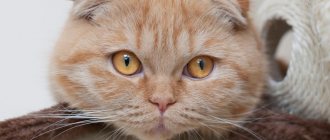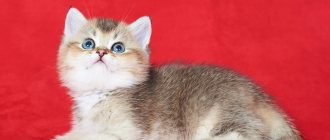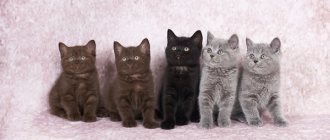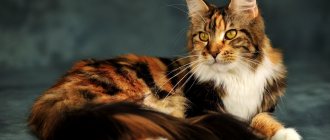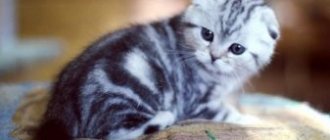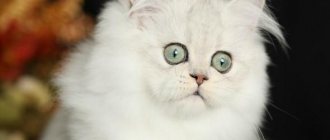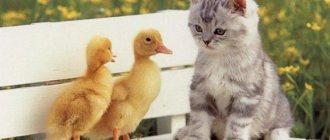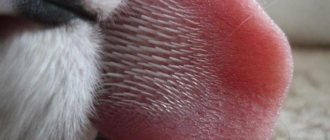The color of a cat's fur, like its pattern, length and texture, is determined by genetics. Understanding how different colors are formed is quite difficult because many genes are involved in the process. If you understand this issue thoroughly, you can easily combine different colors of animals for mating and obtain the required colors.
Differences in color are determined by the physical parameters of the hair and do not depend on the breed of the cat. An animal can display the color of a particular variety without actually being it. For example, a Siberian might wear the color-point pattern that is stereotypical of a Siamese cat.
Mr. Cat Explains: About the Genetics of Colors
Various alleles and genes are responsible for the formation of coat color. The basic shades and patterns of a cat's fur are determined by fewer than ten genes.
It is easier to understand the question of how the colors of a cat’s fur are formed by considering groups of colors. They are usually divided into:
- Solid or solid;
- Ticked;
- Tabby;
- Tortoiseshells;
- Shaded or smoky;
- White;
- Color-point or acromelanistic;
- Silver and gold.
Group of solid colors
The gene responsible for dark tones B/b promotes the production of an enzyme that is involved in the metabolism of the production of the pigment eumelanin.
Its dominant form B produces carbonic eumelanin. It has two recessive forms, b (chocolate) and b1 (cinnamon), with b1 being recessive to B and b.
The chocolate color has a rich brown color and is called chestnut in some breeds. Cinnamon is light reddish brown.
The sex-linked Orange O/o allele predicts whether a cat will produce eumelanin. In animals with red fur, pheomelanin (orange pigment) completely replaces eumelanin (black or brown pigment).
The orange gene is located on the X chromosome. The orange allele is O and is dominant to the non-orange o.
Males are most often orange or non-orange, as they have only one X chromosome. Since females have two X chromosomes, they also have two alleles of the Orange gene.
The combination of OO genes produces orange fur, oo produces black or brown fur, and Oo produces tortoiseshell fur, where some parts are red and others are not. Read whether there are tricolor male cats.
Male tortoiseshells are known to exist, but genetics suggest they are rare and often exhibit chromosomal abnormalities. Typically, less than a third of Tortie cats have a simple mosaic of XXY chromosomes, although Klinefelter karyotypes (genetic chimerism) do occur, and about a third have no XXY components at all.
The orange color is usually called red by breeders. Its other names are yellow, ginger and marmalade. Typically show red cats are bright orange in color, but they can also be yellow or light tan in color.
Orange is epistatic (dependent) on other alleles, which is why all red cats are tabbies. Solid red show cats tend to be low-contrast tabbys.
The color density gene D/d is a carrier protein and is involved in the transport and deposition of pigment in growing hairs.
When a cat has two of the recessive d alleles (Maltese breeding), black fur becomes "blue" (appears grey), chocolate fur degenerates into "lilac" (appears light brown), cinnamon fur becomes fawn, and red fur becomes cream. .
Other genes are also involved in the formation of coat color:
- Barrington Brown is a recessive darkening gene that dilutes black to mahogany, brown to light brown, and chocolate to pale coffee. It is different from the browning gene and is observed only in experimental cats.
- The dilution modifier gene Dm “caramelizes” and weakens dominant colors. The existence of this phenomenon as a separate gene is a controversial issue among felinologists.
- A mutation in the E/e expansion locus (melanocortin receptor) changes the black pigment to amber or light yellow. This phenomenon was first identified in Norwegian forest cats.
- A modifying factor has also been suggested for shaded silver Persians and chinchillas, whose fur becomes pale golden in adulthood due to low levels of pheomelanin production. The fur of these cats appears to be shaded. This is likely due to a phenomenon known as "tarnish" in silver.
Prominent representatives of solid colors are British Shorthair, Russian Blue, Nibelungen, Chartreuse.
British Shorthair
Russian Blue Nibelung
Chartreuse
We recommend an article about gray cat breeds.
Rare cat colors
We see cats almost every day. They live in the basements of our houses, and at sunrise they come out into the courtyards in anticipation of feeding from compassionate aunties, schoolchildren or ancient old women. Among the yard representatives there are also rare colors of cats. But the full saturation of the palette of amazing colors can only be seen in purebred cats.
The colors of barn cats and female cats have become familiar. Since childhood, we know that cats come in black, gray, white and red colors, and that at night they all appear gray. This is where our not very deep knowledge about the colors of cats ends.
However, there is a whole science of breeding purebred cats with amazing colors, about which the hardened average person has never heard anything, but when he saw the elite representatives of the highest cat race at the exhibition, he opened his mouth in amazement.
In this article, in an everyday and popular form, the reader will be told what colors our four-legged friends come in, called by nature to exterminate small rodents.
Thanks to felinology, the science of breeding cats of rare colors, scientists were lucky enough to achieve outstanding results. But the true color of a cat's fur is revealed only after six months of its life. A purebred cat is considered to be an animal whose coat matches the color of its earlobes, nose, eye color and paw pads. However, genetics often fails and the individual, on whom great hopes were pinned, is rejected and dropped out of the ranks of purebred and well-born animals.
Each cat breed has its own typical color. For example, “British” cats are characterized by the color “black or blue smoke”, and animals of a tortoiseshell, smoky or purple color are not at all characteristic of this race. This means they represent a different breed.
Speaking about animals with spots on the coat, it should be noted that these flaws are not acceptable among cats of chocolate, silver and lilac colors, although undercoats with different tints and an even sheen are acceptable here.
Tortoiseshell color
Tortoiseshell color , for example, is formed from three colors: black, white and red tones. But, according to experts, cats can also be smoky. This is facilitated by the presence of gray or silver-white hairs in the coat. When such a cat does not move, it is difficult to determine the true color of it, but as soon as it jumps up and jumps, its fur begins to glow in different shades.
Blue cat
Let's consider blue color as the most common and popular among breeders. These cats are mostly gray in color, with some other shades mixed in. The carriers of this coat are English and Russian cats. The difference between a “British” cat and a Russian one is the color of its eyes – orange or copper. Any spotted combinations on the coat of blue cats are not allowed. The work of breeders will be considered in vain if experts discover this discrepancy with the breed trait.
Although, according to most cat owners, they, in principle, do not care about complete compliance with the standard, since this does not make their beloved pets any worse. They are just as loyal and loving with their owners as individuals of the highest cat races.
Lilac cats
Cats of a lilac color - very romantic and delicate - are also considered a British breed, although it is known that in ancient times animals bred in the east had wool with such iridescence. But we must not forget many historical facts, when hundreds of merchants arrived in medieval England with various goods, who could also bring cats.
The fur of kittens of this breed resembles the color of a forget-me-not petal. Exactly the same color is found on the nose, on the pads of the paws, and around the eyes of the animal.
Golden color
Golden color is the rarest. It includes animals with brindle, spotted or marbled colors. As a rule, individuals with this color represent the breed of chinchillas, Siberian, Persian and golden European cats. Golden coat color for a more understandable definition is light apricot tones.
Spotted cats
Spotted cats are a category of animals with an unusual color, in scientific language - tabby. The ancient brindle and marbled color of the cat, as well as the presence of any intricate or mysterious pattern on their fur, or stains - this is an indicator of this variety. But, if cats with all the listed indicators of fertility do not have a spotted rim under the eyes, near the nose or mouth, or on the neck, then the animals do not fall into this category.
Brindle color
Scientists believe that brindle or merle-colored cats with patterns on their coats were inherited from their ancient and wild ancestors.
Breeding cats is a very labor-intensive process. It can take decades to develop one particular breed. But, given the public’s love for rare breeds with their fantastic colors, breeders do not skimp on investing heavily in this matter. The costs then pay off threefold or tenfold.
In foreign countries, wealthy people spend incredible amounts of capital, by our standards, to buy cats. Special veterinary clinics, hairdressers, and original cat jewelry stores have been created for these elite animals. An entire industry caters to the cats of millionaires and billionaires, who are exhibited at major international exhibitions, where foreign “badgers” and “Murziks” are awarded real cups in various categories.
If you find an error, please select a piece of text and press Ctrl+Enter.
White color
White color also belongs to the solid or solid color, but due to the difficulties of its reproduction, it is separated into a separate group.
It has long been thought that white spotted and dominant white colors are created by two separate genes, but in fact they are both found on the KIT allele.
White patches can take many forms, from a small marking to the profuse snow pattern of a Turkish Van, while epistatic white produces a completely snow-white cat.
Turkish van
The main characteristic of the Burmese cat, specific recessive “gloves,” are also produced by this gene.
Burma has white paws
The KIT allele has the following modifications:
- WD is a dominant white color associated with blue eyes and deafness. Deafness occurs due to a reduction in the population and survival time of melanoblast stem cells, which in addition to establishing pigment-producing colonies develop into a variety of neurological types. White cats with one or two blue eyes are especially likely to be deaf.
- WS – white spot. This gene shows variable expression, with heterozygous cats being anywhere between 0-50% white and homozygous cats being 50-100% white.
- w – wild type, without white spots.
- wg is a recessive gene, and it is its presence that is responsible for the appearance of “gloves” in Burmese cats.
Read the article about the breeds of white cats, as well as about the signs about them.
Thus, the allele that causes a cat to have white fur is the dominant masking gene. As a result, the cat will have a basic color and pattern. However, when a dominant white gene is present, this pattern will not be expressed. A cat that is homozygous (WW) or heterozygous (Ww) for this gene will have white fur. A cat that lacks this dominant masking gene (ww) will have a different coat color.
A common misconception is that all white cats with blue eyes are deaf. It is possible to have a cat with a natural snow coat without this gene, as an extreme form of white patches, although this is rare - usually the animal is left with a small mark of a different color on the body. Although congenital sensorineural deafness is common in white-coated domestic cats, it is caused by degeneration of the inner ear.
Deafness can occur in white cats with yellow, green, or blue irises, but is most common in the latter. It has been found that in white cats with different colored eyes, deafness most often affects the ear on the blue-eyed side.
One 1997 study of white cats with varying degrees of hearing loss found that 72% of the animals were completely deaf. The entire organ of Corti degenerated within the first few weeks after birth; however, even during this period, no brainstem responses could be evoked by auditory stimuli, suggesting that these animals never experienced any auditory sensations.
It has been found that 17 to 22% of white cats with non-blue eyes are deaf, 40% of odd-eyed snow cats with one blue eye are deaf, and 65 to 85% of blue-eyed white cats also cannot hear at all.
The Anatolian cat can be partially or completely white.
Turkish Vans are also partly white. They can also be completely white, but in this case they are considered mestizo, a cross with the Turkish Angora.
Turkish Van: cat and kittens
Turkish Angoras, Persians, Siamese (Foreign Whites), Cornish Rex, Khao Mani, Russian White, British Shorthair and Scottish Fold and others can be completely white.
Scottish lop-eared
Russian white
Persian
Foreign white
Cornish Rex
Kao-mani White color
Faun
Looks like lilac, but is actually a lightened version of cinnamon, or cinnamon color. It is found in Abyssinian cats and has a light beige tint that can be compared to coastal river sand. You can read more about it in our article “Fawn color in Abyssinian cats.”
Agouti and non-Agouti, Ticking and Tabby
Tabby cats are tabby due to the Agouti gene. Their markers have an even distribution of pigment, while the background consists of hairs colored along their entire length in different colors.
Common signs of tabby cats are as follows:
- A mark on the forehead in the shape of the letter "M", which is clearly visible in clear tabbies and slightly visible in ticked ones.
- A mask of thin lines (“pencil lines”) on the muzzle; this feature is also more pronounced in striped and spotted individuals.
- Framing the eyes in the form of black rings with white rings on top.
- Dark coloration of the mouth and paw pads.
- The nose sometimes retains a pink tint, but is either darker than in respectable ones, or has a pigmented rim.
- Stripes encircling the body, limbs and tail. They “dissolve” on the body of ticked cats.
The Agouti A/a gene is a signaling protein. The dominant wild type A causes the Agouti shift phenomenon, which manifests itself in a flattening of black and red hair coloration (revealing the basic tabby pattern), while the recessive non-Agouti or "hypermelanistic" allele A, prevents this shift towards pigmentation.
Toyger cat
The homozygous aa form produces black pigment throughout the hair growth cycle. Thus, the non-Agouti (aa) genotype masks or hides the stripe pattern, although suggestion of an underlying pattern (called "ghost stripe") can sometimes be seen, especially in kittens.
The O allele is also epistatic over the non-Agouti genotype. That is, as a mutation it has no noticeable effect on red or cream cats, causing them to develop striped stripes regardless of their genotype at this locus. This explains why it is common to see a striped pattern on the orange spots of non-Agouti cats.
Prominent representatives of these colors are Abyssinians and Chausies (ticking), Bengals, Toygers, Savannahs, Serengeti, Ocicats (tabby).
Abyssinian
Chausie
Bengal
Savannah Teuger
Ocicat
We create communication
Nature has endowed cats with a genome that allows them to have fur of various shades - from red to lilac, from snow-white to chocolate - and variations: solid, smoky, marbled, tortoiseshell, point... But even among such diversity, the rarest cat colors can be distinguished.
Red Solid
In felinology, red is the red color and its variations - red marbled, red tabby (striped), red smoky, red color-point (acromelanic heat-dependent color in cats genetically related to the Thai and Siamese breeds), red solid (solid red), different variations of cream - “diluted” red.
It would seem that what a rarity is a red cat?
In fact, it is not so easy for breeders to get a purebred kitten of red color: it can only be guaranteed to be born from both parents of the same color. Of course, there is also chance, which professional breeders do not rely on.
The second caveat: it is almost impossible to see a solid red color without spots, light undercoat or stripes - at best, in cats of the “red solid” color, stripes on the paws and tail will still show through slightly and in certain lighting.
In addition, red color is very rare for females: among red whiskered cats, approximately 75% of cats and only about 25% of cats, and this is again due to the complex sex-dependent system of inheritance of the corresponding gene: a female kitten of red or cream color can only be born from such the same father and mother, who have red or cream colors in the genotype, and the coincidence of all these inputs is rare.
Chocolate
A beautiful, uniform dark brown color is truly rare for one simple reason: nature did not come up with a separate gene for it. The chocolate coat color is the result of a recessive condition of the black coat gene, in which eumelanin (the melanin responsible for black coat color) is oxidized, causing black to turn brown.
Due to the recessive nature of such a gene, it “works,” that is, is passed on to the offspring only if the second parent has exactly the same gene. That is why the iridescent chocolate coat is the privilege of purebred cats. Such a kitten can only appear in the litter of both chocolate parents - and even in this case there is no guarantee.
The color does not appear immediately: chocolate or not, it becomes clear only after a year and a half; the kitten can “overbloom” and have grayish, brown fur, as well as translucent stripes - tabby.
An adult chocolate cat should not have any white or other colored hairs, stripes or spots.
Lilac or lilac
Complex “solid” color, which combines shades of pink and blue, cream and gray, pale lilac and violets. Light, dark, deep, pearlescent - the variety of lilac colors is impressive.
Lilac color is found in British, Scottish, Carthusian cats, as well as Burmese - and they prefer warm rather than cold shades.
It is even more difficult to obtain lilac kittens than chocolate ones, because this requires a match in the parents not only of the recessive black genes responsible for the “chocolate” shade, but also the match of another pair of recessive diluent genes of this very “chocolate” - the lightening gene.
The lilac color is often confused with another also rare and “difficult to obtain” color - faun, or sandy, light beige. Sometimes you can distinguish a light lilac color from a faun by the pigmentation of the nose and paw pads: they are darker, with a lilac tint.
Faun and cinnamon
Deer, the color of a roe deer, the color of sea sand - there are many comparisons, but the meaning is the same. Faun is a very beautiful beige color. It should not be confused with cream - a highly diluted red.
Cinnamon literally means “cinnamon”.
Genetically, the “fawn” color is a highly bleached lilac, and the “cinnamon” color is a diluted chocolate color. They are inherited only if there is one parent of this color and the second is the carrier of the entire combination of recessive genes responsible for these colors.
To calculate the future "fawns" and "cinnamons", breeders make complex, almost mathematical calculations, carefully studying the genetics of the parents. Felinological systems, before issuing a document with a mark on such colors for each specific kitten, require a confirmatory genetic test.
Chinchilla
Contrary to popular misconception, the chinchilla is not a cat breed, but an amazingly rare color: the tip of each hair is ticked, that is, painted black. Due to this, the cat seems as if shrouded in a mysterious veil, and its fur shimmers and turns silver.
However, the silver chinchilla - with a pure white undercoat - is just one of the variations, although a very beautiful one. In addition to her, there are golden, blue, chocolate, lilac and cream chinchillas.
There are also many breeds in whose representatives you can find the chinchilla color: Persian, British, Scottish, exotic, Burmese and other cats.
The chinchilla color was first identified in a Persian cattery in Great Britain in 1882, and since then has captivated many breeders and cat lovers around the world with its beauty.
Ideally, only one-eighth of the hair should be dyed - such cats are valued the most, but more “shaded” cats also have their own standards and classes. All chinchilla cats have another similarity in appearance: bright emerald or cornflower green eyes outlined in black pigment, as well as a brick-red nose edged in black.
Tortoiseshell colors
Genetically, Tortie cats are tortoiseshell in every way except that they express the white spotting gene.
However, there is one anomaly, generally the larger the white areas, the smaller and larger the patches of tan and dark or striped areas.
Unlike Torti, cats that do not have white spots usually have small markers of other shades or even areas that are figuratively called “salt and pepper.” This reflects genetic influences on the relative rate of melanocyte migration and X-inactivation in the embryo.
Serious research on tortoiseshell cats began around 1948, when Murray Barr and his graduate student E.G. Bertram noticed dark, drumstick-shaped masses inside the nerve cell nuclei of female cats, but not those of males. These areas became known as Barr bodies.
In 1959, Japanese microbiologist Susumu Ono determined that Barr bodies were X chromosomes. In 1961, Mary Lyon proposed the concept of X-inactivation, where one of the two X chromosomes inside a female mammal is switched off.
Calico cats are almost always female because the gene locus for orange/non-orange coloration is on the X chromosome. In the absence of other influences such as color inhibition that causes white fur to be produced, the alleles present at these orange loci determine whether the hair is red or not.
Female cats, like all female mammals, usually have two X chromosomes. In contrast, placental male mammals, including chromosomally stable male cats, have one X and one Y chromosome. Since the Y chromosome does not have a locus for the red gene, there is no chance that an XY male could have both the orange and non-orange genes together, which is necessary to create the tortoiseshell coloration.
The only exception is that in rare cases, defective cell division can leave an extra X chromosome in one of the gametes that is capable of reproducing a male cat. This extra X chromosome is then copied in each of his cells, causing a condition called XXY, or Klinefelter syndrome.
All but about one in three thousand rare tortoiseshell males are infertile due to a chromosomal abnormality.
Tortoiseshell color is characteristic of many elite varieties, it is especially common in female Maine Coons, Siberian cats, Neva Masquerade cats, Norwegian Forest cats, but is also characteristic of outbred pets.
Color point and albinism
The color point pattern is most often associated with Siamese cats, but can also appear in any domesticated cat.
Such an animal has a dark mask on the face, ears, paws and tail, with a lighter version of the same color on the rest of the body and perhaps some white.
Color Point Ragdoll
The exact shade of the color pattern depends on the actual coloring, so there are various points - dark brown, chocolate (warm light brown), blue (dark grey), lilac or frost (silver-gray-pink), red or orange, tortoiseshell.
This pattern is the result of a temperature-sensitive mutation in one of the enzymes in the tyrosine-to-pigment metabolic pathway, such as melanin. Thus, little or no pigment is produced, except on the extremities or points where the skin is a little colder. For this reason, color point cats tend to darken as they age as their body temperature drops.
In addition, due to significant trauma, fur can sometimes also darken or lighten as a result of changes in body temperature.
Mutations in the early stages of the tyrosine pathway can affect not only pigment but also neurological development. This leads to a higher incidence of squinting eyes in colorpoints.
The gene responsible for acromelanistic colors and albinism is designated C and exists in the following modifications:
- C – full color.
- cb – Burmese sepia pattern, similar to color dot but with lower contrast.
- cs – Siamese color. This combination is similar to cb, cb/cs cats have a medium contrast phenotype known as the mink coloration.
- ca – blue-eyed albino.
- c – albino with pink or red eyes.
The Siamese and all breeds derived from it, for example, the Sacred Burma and Ragdoll, have color-point colors.
Silver and gold colors
The silver color in cats is caused by the melanin inhibitor I/i gene.
Its dominant form helps suppress melanin production, but affects pheomelanin (red pigment) much more strongly than eumelanin (black).
In tabby and spotted cats, this turns the background into a sparkling silver, leaving the color stripes intact, creating a silver tabby. In respectable cats, the base of the hair becomes pale, which makes them look like silver smoke, these are the so-called shaded or shaded colors.
Silver Agouti cats can have a range of phenotypes, from silver tabby, silver medium ticking (less than half of the coat is pigmented) to silver-tipped hair (chinchilla coloring).
The amount of pigmentation depends on the hypothetical "broad band" factor. Breeders use this term to refer to the presence of the Wb/wb gene.
If the pet has the broad stripe trait but does not have the inhibitor, the coloration will be gold instead of silver. These cats are known as golden tabbies.
golden tabby
A golden tint is also possible. However, there is no golden smoke because the combination of wide stripe and non-Agouti simply produces a solid cat.
The genetics involved in producing the ideal tabby or ticked cat, as well as the shaded or smoky cat, are complex.
Not only are there many interacting alleles, but genes sometimes don't express themselves fully or conflict with each other. For example, the melanin inhibitor gene in some cases does not block the pigment, resulting in a gray undercoat or darkening (yellowish or rusty fur).
Likewise, poorly expressed non-Agouti or overexpression of a melanin inhibitor causes pale, blurry black smoke.
It is believed that different polygenes (sets of related genes), epigenetic factors or modifier genes, as yet unidentified, lead to different color phenotypes, some of which are considered more attractive by felinologists.
Silver and golden colors are found, for example, in Bengal, British, Scottish cats, and Persian chinchillas.
Silver Bengal
Chinchilla
An extremely complex color, the genetics of which are not fully understood. Even experienced breeders who have been coloring for a long time have problems. With a chinchilla color, the base of the hairs is almost white, and the tips are colored in one of the usual colors. The whole secret is in the ratio of white and dyed, that is, where in the hair the transition begins. This is what determines whether the animal will look as magical as in these photos.
You won’t find chinchillas among outbred cats, but there are such animals in nature. The rodent that gave the color its name, without any effort from the breeders, has a coat of such a rare color.
Larisa Solodovnikova
Shaded and smoky colors
Genetic influences on this type of coloring have:
- Gen Agouti.
- Tabby pattern alleles such as T (tabby pattern).
- Silver or melanin inhibitor gene.
- Factors influencing the number and width of color bands on each hair (for example, a hypothetical broadband gene).
- Reasons that influence the quantity and quality of expression of the eumelanin and/or pheomelanin pigment.
- Genes that cause coat glitter, such as the shiny coat of Bengals.
- Factors responsible for eliminating residual streaks (hypothetical chaos, disorder, non-confusion, erasing the pattern).
Smoky colors are characteristic of many breeds - Siberian, Russian Blue, Maine Coon, British, Scots, Burmilla.
Fur length and texture
The length of a cat's fur is determined by a gene in which the dominant L form codes for short hairs, and the recessive L form codes for long hairs.
In a longhaired cat, the transition from anagen (hair growth) to catagen (hair cessation) is delayed due to this mutation.
A rare recessive shorthair gene has been discovered in some lines of Persian Silver cats when two longhaired parents produce shorthaired offspring.
The length of a cat's fur is also controlled by the fibroblast growth factor gene. The dominant allele codes for short hair in most cats.
Long fur is encoded by at least four different recessively inherited mutations. The most common of these is found in most or all long-haired breeds, with the other three found only in Ragdolls, Norwegian Forest cats and Maine Coons.
Many genes have been identified that lead to a cat's unusual fur. They have been found in randomly bred cats that are strictly controlled. Some of them are endangered, so such animals are not sold outside the region where the mutation occurred.
In many breeds, coat gene mutations are undesirable. An example is the Rex allele, which appeared in Maine Coons in the early 1990s.
Rexes originated in America, Germany and Britain, where one breeder caused confusion by calling them "Maine waves." Two British breeders carried out mating tests which showed that this was likely a new Rex mutation and that it was recessive.
Rex fur
The animals' coat density was similar to Maine Coons with a normal coat, but consisted only of downy-type hair with a spiral curl. The mustache was more curved, but not curly.
There are various genes that produce curly or "rex" cats. New types of them arise spontaneously from time to time in random breeds of cats.
Here are some of the Rex genes selected by breeders:
- r – characteristic of Cornish Rex, recessive.
- gr – present in German Rexes, recessive. The locus here is the same as in Cornish, but proposed as a different allele. However, most breeders believe that the German Rex has an r/r genotype.
- re - characteristic of Devon Rex, recessive.
- ro – it was possessed by the now extinct Oregon Rex, recessive.
- Se - carried by Selkirk Rex cats, dominant, although sometimes described as incomplete dominance because the three possible pairs of alleles relate to three different phenotypes - heterozygous cats (Sese) may have a fuller coat, which is preferred in the show ring, while as homozygous cats (SeSe) have a tight curl and less hair volume.
- Lp (preliminary) – responsible for the emergence of La Perms, dominant. In this case, Lp/lp and Lp/Lp individuals have the same phenotype.
There are also genes responsible for hairlessness in cats:
- h – its carrier is the French Hairless cat, recessive.
- hd – characteristic of the British hairless cat, recessive.
- Hp – it is possessed by the Don Sphinxes and Peterbalds, dominant.
- hr – responsible for the appearance of the Canadian Sphynx, recessive.
Some Rex cats are prone to temporary hairlessness during shedding, known as alopecia.
Here are a few other genes that lead to cats with unusual fur:
- The Wh gene is dominant, possibly incomplete, leading to the appearance of wire-haired cats. They have bent or crooked hairs that form springy, wiry fur.
- The hypothetical Yuc gene causes cats to be born without undercoat. However, the proportional relationship between guard hair and down coat varies greatly among all breeds.
- A recessive autosomal gene for onion hair that causes roughness and swelling in the hair. Edema occurs due to an increase in the inner nucleus of the medulla cells.
- Recessive autosomal gene spf. The fur of such animals is sparse, the hairs are thin, uneven and curved, there is a brown coating and bare areas around the eyes and nose, chest and belly.
Types of colors
Thanks to the work of breeders, we can now observe countless color variations.
- tabby,
- solid (solid),
- piebald,
- silver,
- colorpoint,
- acromelanic.
Tabby is a fur pattern that can be present in animals of any type of color. There are several options:
- spotted,
- striped (brindle),
- marbled (spiral stripes along the body, triple stripes along the ridge),
- ticked (present only on the muzzle; uneven coloring is also characteristic).
Solid. Characterized by an even distribution of melanin and the absence of spots and marks on the animal. Each hair is evenly dyed to the very base of the root. The following are the main types of solid colors:
- black,
- red,
- chocolate,
- tortoiseshell (red and black),
- blue,
- cream,
- tortoiseshell (blue and cream).
Piebald. Assumes the presence of colored areas on a light background.
- van, the entire fur coat, with the exception of the tail, is light. There may also be spots on the head and neck,
- harlequin, uncolored dominates, but there are also small colored areas throughout the body,
- bicolor, this subspecies is distinguished by small spots on various parts of the body. There are several varieties of bicolors, tuxedo (uncolored areas are located on the chest and paws), with gloves and with a medallion, paws and chest are white,
- tricolor, a combination of white and tortoiseshell. The first, as a rule, prevails.
Silver. Such kittens are characterized by a zoned distribution of pigment in each of the hairs, as a result of which some parts of the body remain completely unpigmented.
This group is also divided into:
- smoky (half the hair is colored, and the other half is undyed),
- silver tabby (these whiskers, in addition to the zonal coloring of each of the hairs, also have a pattern on their fur coat),
- shaded (most of the hair remains white),
- chinchilla (only a tiny tip is painted).
Acromelanic (Colorpoint), paws, muzzle and tail have a bright and rich color, body is light.
